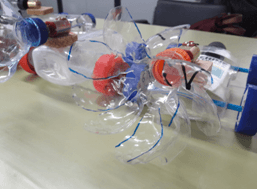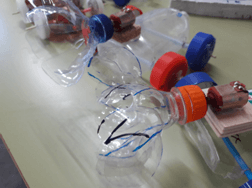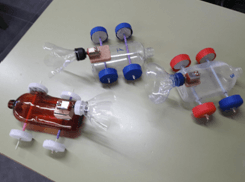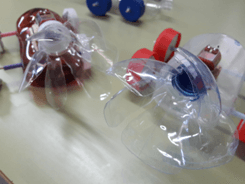Technology (STEM)
3-5-7 Bladed Propeller
Images

3d model information
Technology:
FDM
Material:
PLA
Sizes:
130X130X50 mm (aprox)
Accuracy:
Medium
Resistance:
Medium
Printing time:
4H
Number of pieces:
1
Links and resources
STL Files Viewer
Summary
This unit is about Materials and Electricity. Students will work in a collaborative way by means of the project-based learning methodology. They will have to design, draw and build a vehicle using some waste materials (soap bottle for the bodywork, caps for the wheels…) and electrical components (motor, wire, battery…). This vehicle will be driven by a 3, 5 or 7 bladed propeller 3D printed, that will be screwed to join the motor throughout a standardised bottle cap.
Learning objectives
- To design a prototype to find a solution to a technical problem throughout the technological process.
- To create the required reports in order to plan and build the prototype.
- To interpret technical drawing, plans and sketches as an information element of technological products.
- To represent using views and perspectives objects and technical systems, throughout sketches and plans with standardisation criteria regarding scales and annotation.
- To identify and manipulate the workshop tools in forming operations of technical materials.
- To complete the project worksheet attending health and security rules.
- To design basic electric circuits by means of specific software and using standardised symbology and to experiment with the elements that configure them.
- To design and assemble basic electronic circuits using bulbs, buzzers, LED diodes, motors, batteries and connectors.
- To describe the characteristics of technical materials comparing their properties.
- To explain how to identify the mechanical properties of technical materials.
Teacher preparation
- The Technology teacher will prepare the worksheet and digital presentation to introduce the project to the students.
- Both materials and tools will be ready to use in the workshop.
- A template for the report will be given to the students so that they can fill it in whilst they are in the design and build phases of the Technical Process.
Teacher explanation
- The teacher explains the topic and objectives of the project.
- Students must know previously the basics of technical drawing, technical materials properties, electricity, tools, health and safety rules in the workshop and the different parts of a project report.
- Explanation of 3D printers functioning and 3D design guide.
- Split up the students intro groups of 3.
Student activity/Steps
In each group of 3 students they will have to design and build a vehicle and deliver the technical report of this project. The steps to follow are:
- Design and draw the vehicle and wiring diagram: plans using scales and annotations.
- 3D print the propeller.
- Build the vehicle.
- Evaluation of its functioning: speed, direction, friction.
- Delivery of the technical report of the project, including requirements, plans, wiring diagram, worksheet, used materials and tools, and individual feedback about the didactic unit.
General Info
Age of students
13-14
Skills needed
3D printing, computer design
Duration
4 periods
Individual/Groups
Group
Materials
PLA, plastic container, straws, skewer sticks, hot glue, motor, wire, battery
Tools
Soldering iron, hot glue gun, scissors, pliers, cutter
Software
Cura, Tinkercad
License Info
License name:
Attribution 4.0 International (CC BY 4.0)
License details:
You are free to:
Share — copy and redistribute the material in any medium or format
Adapt — remix, transform, and build upon the material
for any purpose, even commercially.
Under the following terms:
Attribution — You must give appropriate credit, provide a link to the license, and indicate if changes were made. You may do so in any reasonable manner, but not in any way that suggests the licensor endorses you or your use.
No additional restrictions — You may not apply legal terms or technological measures that legally restrict others from doing anything the license permits.
More info:
I printed it
If you printed this exercise you can register and share it with the community:
Create a new accountOr Login if you are registered.




